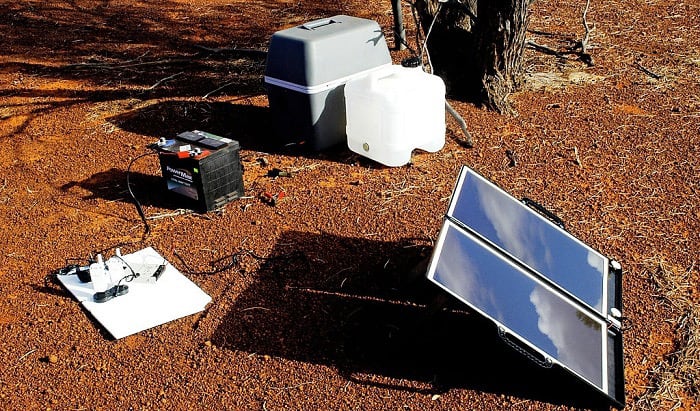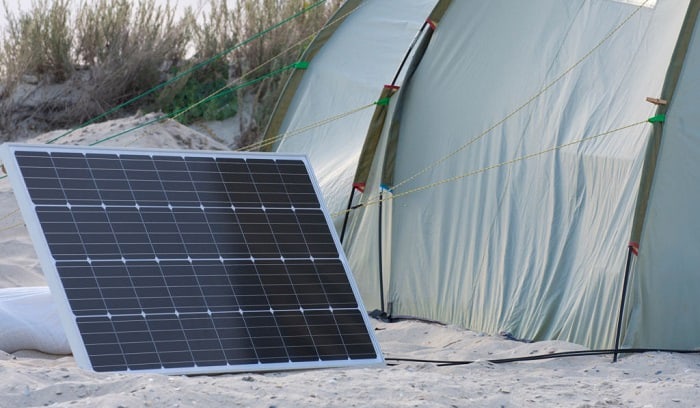What size solar panel to charge 100Ah battery? Basically, the number of solar panels required to charge a 100 amp battery primarily relies on several factors, such as the power output of your solar panels and battery voltage. Indeed, you’ll need to consider the number of sunlight hours that your solar panels obtain.
More importantly, the number of solar panels you require depends on how quickly you prefer to charge your battery. But, generally speaking, a 100 Ah battery would call for a 180W solar panel to fully charge from 50 percent DOD presuming 4.2 peak sun hours a day. On a bright sunny day, it will require eight hours to charge fully.
Let’s discuss this topic more below.
Table of Contents
- What is the Most Recommended Type of Battery for Your Solar Panel System?
- How Can You Figure Out the Size of the Solar Panel Required?
- What’s the Optimal Solar Panel Size Required to Charge a 100 Ah Battery?
- The Time It Takes to Charge Your 100 Ah Battery
- Charging Your 100 Ah Battery With Your Solar Panel
- Frequently Asked Questions
- The Bottom Line
What is the Most Recommended Type of Battery for Your Solar Panel System?
Typically, a set of batteries or a battery will save the solar energy captivated by the solar panels. So, what battery types are best fitted for this application?
Specific batteries are excellently designed for solar energy storage, including lead-acid, lithium-ion cell, or saltwater cell batteries.
Nonetheless, due to the more advanced setup of li-ion batteries, they are considered the most excellent option for storing solar energy. Furthermore, they commonly have an extended lifetime and are more lightweight than saltwater cells and lead-acid batteries.
Meanwhile, you can purchase lead-acid batteries if you intend to use them only for your home. They are less expensive compared to li-ion batteries; however, they require frequent replacements.
On the other hand, saltwater cells are eco-friendly alternatives among the three since and play a valuable role in current transmission. You can recycle them, unlike lithium and lead cells.
In general, the lifespan of a photovoltaic module or solar panel is roughly 25 years or more, while the battery life ranges from 5 to 15 years. We strongly suggest replacing the battery at least once so that you can utilize them without any issues. This way, you could match the capacity of the solar panel system.
A Reminder: lead-acid batteries should merely be discharged between 20 to 80 percent. It will depend on if they are deep-cycle designs or standard vehicle-type batteries. Lithium-ion cells, on the other hand, can be nearly emptied.
How Can You Figure Out the Size of the Solar Panel Required?
When deciding what size of solar panel you need to charge your equipment, please note that this could differ depending on your criteria. Such criteria involve your budget, setup location, what devices you prefer to run with it, and future power plans.
It is asserted that larger solar panels have reduced expenses; hence, it’s ideal to choose larger models that could generate up to 5 kilowatts. Nevertheless, the solar panel system depends on electricity consumption. So, you’ll need to do the math for that.
Before doing the computations, let’s first uncover the following terms for measurements:
Watt = W
Voltage = V
Amp-hour = Ah. Ah is one of the actual numbers you should consider when investing in a battery. It refers to the amount of power that you could save in a battery.
Now, let’s proceed to calculate watt-hours:
To determine the watt-hours, you would need to multiply battery amp hours with the battery watt. Then, you need to compute the total watts of the solar panel you require; to do so, divide watt-hours by the number of hours of sunlight that the panel obtains.
Lastly, with the total watts, you only need to multiply it with the efficiency tag, which is approximately 15 to 20%. Afterward, you only need to add this to the total to obtain the actual watts of the panel you need to set up.
This is how it goes:
Watt-hours = battery ampere-hours x battery watt
Total watt-hours of the solar panel = watt-hours divided by the number of hours of sunlight per day.
Actual watts of power of solar panel = total watt-hours plus (the total watt-hours of the panel x efficiency)
What’s the Optimal Solar Panel Size Required to Charge a 100 Ah Battery?
Now that you already know how to compute the solar panel size you require, let’s figure out the optimal size necessary:
For instance, let’s presume that the battery is 100 Ah 12 volt
Watt-hours of 100 Ah battery = 100 multiply by 12 = 1,200 watt-hours
Then, let’s also presume that we obtain 8 hours of sunlight per day
Solar panel’s total watt-hours = 1,200 watt-hours divided by 8 = 150 watt-hours
Lastly, let’s presume that the solar panel is engineered with premium quality and 20 percent efficiency
Thus, actual watts of solar panel = 150 plus (150 multiplied by 20%) = 180 watts
As for the common solar panel sizes sold in the market, many solar panels have the following sizes:
50-watt panel, 100-watt panel, and 120-watt panel
As a result, we need 2 x 120-watt, 2 x 100-watt, or 4 x 50-watt to cover your 180W solar panel to charge a 100Ah battery. Some recommended solar panels: 100 watt solar panels, foldable solar panels and flexible solar panels.
Heads Up: To explore more on how to calculate your solar panel and battery bank size based on your needs, watching this video might help:
The Time It Takes to Charge Your 100 Ah Battery
To determine how long it takes to charge a 100 Ah battery:
Amps delivered = solar panels’ total watts divided by the voltage of the battery
The time required for charging = battery Ah divided by the amps delivered
Thus, Amps = 180 divided by 12 = 15A
The time to charge the battery = 100 divided by 15, so we get 6.66 hours.
Please note that the computation above is an estimate of the time it might require to charge the battery fully.
Substantially, since these computations are based on approximate calculations, it’s best to discuss the recommended size with your engineer or the manufacturer.
Charging Your 100 Ah Battery With Your Solar Panel
There’s no denying that the best green energy source is solar power. Solar devices and vehicles, not to mention giant firms having solar factories, significantly help minimize the usage of non-renewable energy sources. As a result, we can enjoy more sustainable energy.
We can also reduce oil usage or the consumption of nuclear power plants. While installing solar panels can be slightly challenging, it’s not inconceivable.
Many of us have already witnessed the perks of utilizing solar panels rather than conventional electric current.
Ultimately, when choosing solar panel sizes and their chargeability, please note that these depend on installation cost, location, devices you need to run, and sunlight exposure.
Frequently Asked Questions
1. Is it possible to charge deep cycle battery while using it?
It is impossible to gather power from the battery while synchronously charging it. The current could go either into your battery or out of your battery. In short, it does not work in both ways simultaneously.
2. How fast will the solar panel charge the battery?
Generally speaking, a solar panel that generates 1 amp of current takes 5 hours to eight hours (or more) for charging, depending on the battery size.
So, to obtain the most efficient charging via a solar panel, it’s critical to optimize the amount of current by ensuring that there is direct sun exposure.
3. How to gauge the remaining battery capacity?
You can examine your battery’s ampere-hour capacity by examining the terminal volts using a multimeter.
Please remember that it’s a must to leave the battery in a dormant state for roughly six hours before taking the volt reading. This way, no chemical reaction will emerge.
4. Are there factors that could affect the pace at which the solar panel charges?
Definitely yes! The primary factor that could affect the solar panel’s charging speed is the amount of sun exposure. Please note that our computations work only if the solar panel receives ample sun exposure.
This means that it should not be gloomy, and the panel should be free from any obstructions or shade. Otherwise, you could expect a slower charging time.
Meanwhile, another factor is the quality of your solar panels. Of course, top-quality panels are capable of generating more stable power. Additionally, they may also generate more amperes per hour.
The Bottom Line
In this post, you have learned several factors to consider when you charge 12V battery with solar panel. And, determining the size of solar panels required is not as complicated as you imagine.
What size solar panel to charge 100Ah battery? It’s pretty straightforward to work out the size of the solar panel you require for your application. To get started, you only need to ensure that you are well aware of the three primary factors below:
- the Ah of the battery
- the battery voltage
- the average amount of sun exposure per day in your area

I am Kathleen Miller, staff writer and reviewer of the Avasolar team. Working with the team has been a pleasure for me so far, I hope to bring readers useful information by creating detailed and easy-to-follow contents.



